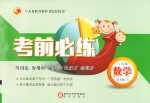题目内容
—It’s our duty to homeless people in earthquake areas food and clothes.
—I agree with you. We should do something for them.
A. provide, of B. provide , with C. provide , for
B
【解析】略

 考前必练系列答案
考前必练系列答案Three kids have been learning chemistry for only a few months. But they have already begun to challenge (挑战) a world famous scientist!
Li Weichi, Huang Runling, and Xiao Yan are from Zhongshan Huaqiao Middle School in Guangdong. They have just found a red cabbage that could be a new kind of acid-base indicator (酸碱指示剂). They want it to take the place of litmus (石蕊) paper.
"We’ve learnt to think of and ask questions about life by ourselves," said Li, "We work well with each other."
British scientist Robert Boyle discovered the use of litmus paper over 300 years ago. Now it is used widely in experiments all over the world.
But when the kids did some experiments in class last winter, they saw that the litmus paper didn’t turn very blue with base matter. It’s hard to get a clear result.
Will there be a better indicator than litmus paper? The three kids decided to try and find out!
How? They went to collect over 40 plants in parks, gardens and markets. Then they ground (研磨) leaves, flowers and stems (茎) to get the pigments (色素) from them.
The kids mixed pigments with acid and base. They spent months watching carefully to see which paper showed the best colour change. They decided it was the litmus paper!
"It’s our first scientific journey, Huang said, "But it makes me want to try harder."
【小题1】 Whom did the three kids want to challenge?
| A.Their chemistry teacher. | B.Their headmaster. |
| C.Robert Boyle | D.Thomas Edison |
| A.plant | B.animal | C.paper | D.liquid |
| A.red cabbage | B.litmus paper |
| C.any plant | D.any flower |
| A.how to make litmus paper | B.about the three kids’ spirit |
| C.scientists were wrong | D.the kids are heroes |
